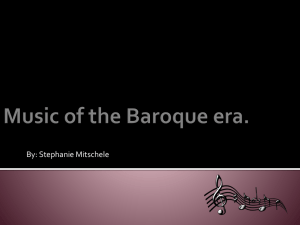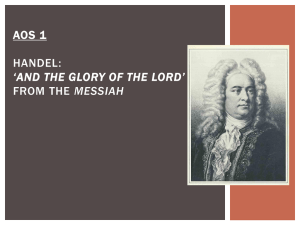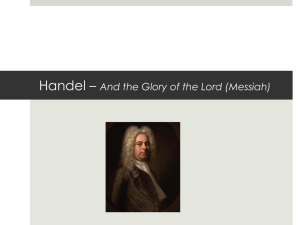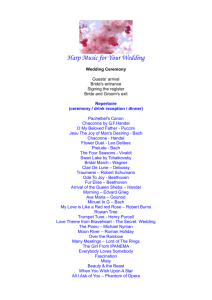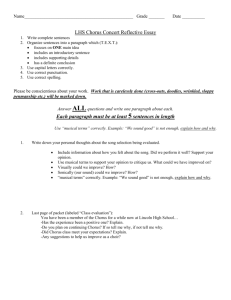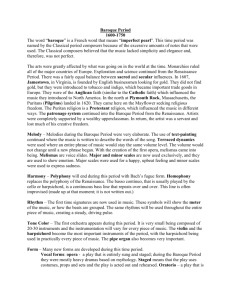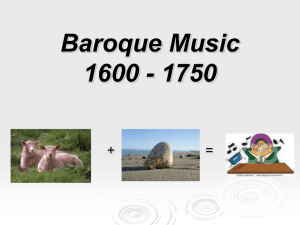Handel_1_6mod
advertisement
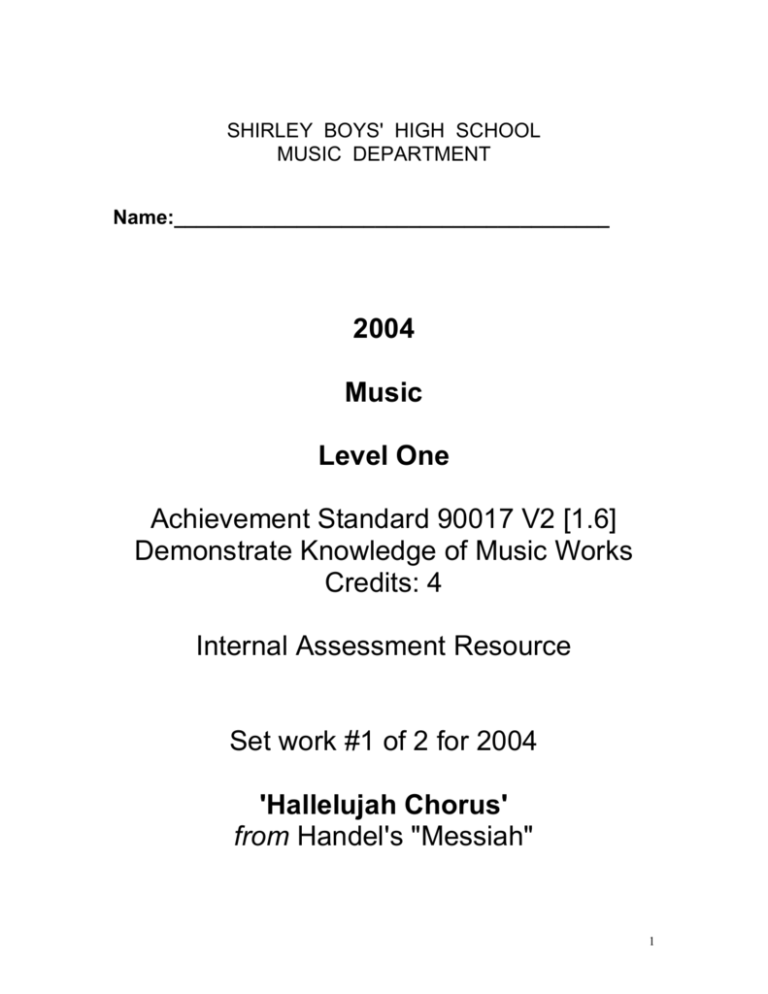
SHIRLEY BOYS' HIGH SCHOOL MUSIC DEPARTMENT Name:_______________________________________ 2004 Music Level One Achievement Standard 90017 V2 [1.6] Demonstrate Knowledge of Music Works Credits: 4 Internal Assessment Resource Set work #1 of 2 for 2004 'Hallelujah Chorus' from Handel's "Messiah" 1 2004 Music Level One Achievement Standard 90017 V2 [1.6] Demonstrate Knowledge of Music Works Credits: 4 Internal Assessment Resource 'Hallelujah Chorus' by Handel ________________________________________________________________ Student Instructions Sheet ________________________________________________________________ Read through all the information given to you before starting work. Make sure you understand what you are being asked to do. Ensure that you know what is required to be working towards an achievement, achievement with merit, or an achievement with excellence grade for this achievement standard. The Context and setting for this task will include the following: 1. The assessment task deadline is Wednesday 19 May, at 8.30am. It must be handed into your teacher by that date and time. 2. This assessment activity, consisting of two tasks, takes place in class over 10 periods and for homework. Resources available to you include handout booklets on the Baroque period, Handel and analysis information, as well as texts in class – a. Music Dictionaries, b. History of Music by Roy Bennett, c. Making Music Your Own Books 7 & 8, d. Score Reading Form and History by Annie O Warburton, e. The Literature of Music by Robert Field-Dodgson. 3. You have spent about seven weeks on pre-assessment activity - studying the themes and listening to the work with score, as well as studying the background to the work (social, and historical and cultural context). 4. You will have most of each of the available ten periods to work on this activity, with direction from your teacher as necessary. 2 Detailed Instructions: This assessment activity consists of TWO tasks, both of which must be completed: TASK 1 Research into the Social and Historical Context of the Baroque period, Handel and Oratorio. & TASK 2 Analysis of the musical elements and features of the Hallelujah Chorus. ----------------------------------------------------------------------------------------------------------TASK 1 Research into the Social and Historical Context of the Baroque period, Handel and Oratorio. Write your answers to this task on A4 refill paper. Clearly label each sheet with your name. Credit will be given for the quality and depth of your answers. For merit or excellence you are expected to go beyond the minimum requirements, and for researching information from a wider range of resources than those just listed on page two. You have been issued information booklets and book references to help you locate relevant material for your written answers. Please use them, and keep them in your ringbinder. A. THE BAROQUE PERIOD 1 2 3 4 Draw a timeline showing the approximate dates of the Baroque period, and include Handel and at least two other main composers. Name, and explain in at least one paragraph, influences on Handel’s musical style. What were the important political and social issues of the Baroque period? Summarise these into at least one paragraph. Write at least one sentence about each musical element of the Baroque era, using the following headings: Timbre Texture Melody Rhythm Modality/ Dynamics Mood Tonality 3 B. GEORGE FREDERIC HANDEL 5 Write a minimum of a one-page summary of Handel's life including: a. When and where he was born (city and country) b. where he lived, including the place he lived in most of his life c. who he worked for d. what kind of works he wrote (genre), including examples e. any other information about Handel’s life that you think is significant to our understanding of him as a composer and WHY you think this is so C. ORATORIO 6 What are the similarities and differences between opera and oratorio? You should compare them by using two lists side by side. You need to consider: staging, costuming, acting, text, voicing, instrumentation, individuals and/or groups, venues, musical forms eg song. List at least one point for each aspect. TASK 2 Analysis of the Musical elements and features of the Hallelujah Chorus. Answer questions as fully as you can, by giving full sentence answers when required. 1 Draw up a table, using the format below. It is advised that you put this in landscape form. Include the following information in the relevant columns: i define each key bolded term ii. find a clear example of each of the terms, using bar number references, and detailing voicing. Eg monophonic texture bars 41 and 42 in the bass part. iii. justify why you have selected this as a clear example. a b c d e f g h Key bolded TERM monophonic texture homophonic texture imitation Fugue (identifying the subject, answer and counter subject) terraced dynamics Modulation word painting polyphonic texture (two different themes combined). i definition ii example iii explanation 4 2 Now, you are to be the Musical Detective – a Musical Forensic scientist. You have been given an extract from the 'Hallelujah' Chorus by Inspector Scott to detect the key features of the music and the fingerprints of Handel’s musical style. Glue your extract onto the middle of an A3 sheet of paper to give you room for identifying, labelling, and explaining the features listed below this diagram. Below is an example of how to identify, label and explain a feature. Bars 46-49 Imitation Soprano part follows the alto 2 bars later Score Extract Identify, clearly label and explain the following features on your extract: a - A pedal b - Homophonic texture c - Polyphonic texture d - A plagal cadence, using Roman numerals, and label it e - Orchestra doubling the voices f - The one instance where an instrument plays without voices g Find an example of word painting. h Repetition i Fragments of main themes. Which fragments of themes are used, and label and name them where they first occur in the extract. Eg Theme #1 j Key or keys in this extract k Melodic sequence L Instrument doubling the voice part, but without a rest in the instrument part. 5 Assessment Schedule 'Hallelujah Chorus' Assessment Tas k Evidence You are working towards Achievement 1 1. Timeline with Baroque dates: 1600 – 1750. Dates for Handel (1685 – 1759) and 2 others eg Bach (1685 – 1750), etc. 2. Influences on Handel’s Style: Travels to Italy Learnt about styles and techniques of Scarlatti in opera and Corelli in instrumental forms English experience – business decision to change from writing operas to oratorios Change of King Timeline shows Baroque dates with Handel and 2 other composers TWO facts expressed in a paragraph You are working towards Achievement with Merit You are working towards Achievement with Excellence AT LEAST THREE facts expressed in a paragraph 1 3. Social/Political Climate during Baroque period: Time of turmoil eg 30 years war Religious persecution End of power of Spain and Rome Age of discovery (scientifically, industrially, socially, artistically and philosophically) Musical experimentation Less domination by the church meant composers could move into other forms of music THREE facts, including at least TWO of: 30 yrs war religious division age of discovery AT LEAST FOUR facts expressed in detail 2 4. Music Elements: Texture: balance of homophonic and polyphonic Rhythm – driving forward provided by basso continuo Mood – one mood throughout an entire movement Timbre – string section basis of orchestra; importance of organ, harpsichord Dynamics – contrasts; use of terraced dynamics; echo effects Modality – Modes replaced by maj/min key system Melodies – spun-out includes ornamentation At least THREE elements expressed, each with at least one fact stated. AT LEAST FIVE elements expressed in some detail. 3 5. Handel’s life: a. Halle, Germany in 1685. b. Lived in Hamburg from 1703 Travelled to Italy, 1706 – 1710 Lived in Hanover - visits to England, 1710 Lived in England for rest of his life from 1712 c. Kapellmeister to Elector of Hanover in 1710 Queen Anne temptress 1712 Elector of Hanover became George I, forgave his truancy and doubled his pension Worked for Duke of Chandos in 1718 Employed under patronage of George II in 1729 d. operas oratorios instrumental music secular choral works church music cantatas/other vocal music (Ref: Warburton p124 for egs) e. any other evidence supplied Some detailed aspects Detailed aspects of 5a – of AT LEAST three areas 5d covered PLUS the of 5a. – 5d. following: Response to 5e includes Responses to 5a – d some information about a. should include Handel’s life that is city, country and significant to DOB understanding him as a b. about 3 of 5 composer. places identified c. about 3 of 5 people identified d. about 4 of 6 kinds of works identified with at least one example for each Response to 5e includes detailed information about Handel’s life that is significant to understanding him as a composer. Student gives a reason as to WHY this might be so 4 6. Opera/Oratorio Differences: Oratorio: Biblical or epic text; no scenery; no props; no costumes; no acting; orchestra; solo/chorus; church performance; overture; aria, recit, chorus. [Opera on next page] Opera: based on myth/legend; scenery; props; costumes; acting; orchestra; solo/chorus; concert hall/theatre performance; overture; aria, recit, chorus. Accurate comparative list of AT LEAST 7 out of 10 features for ORATORIO, and AT LEAST 7 out of 10 for OPERA. 5 2 1. Table format with definitions of key bolded terms, with examples and justifications (explanations): a. monophonic – single, unaccompanied melodic line eg b 12-14: all (tutti) in unison b. homophonic – melodic line with harmony eg b4-11: Theme I in Sops with others giving harmonic support c. imitation – repeating idea by a different voice(s) eg b 6: between choir and orchestra d. fugue - ‘flight’contrapuntal form with main idea (subject); imitation of it another voice (answer), whilst main idea continues with new material (counter-subject) eg b41-50 Theme 4 follows S+A format e. terraced dynamics – contrasted blocks of sound eg b33-41 p/f f. modulation – key change eg b26 to A major – V-I cadence + accidental g. word painting – vivid musical illustrations of the meanings of certain words eg b33-41 T3 – we inferior on earth – Lord above loud, higher pitched h. polyphonic – 2 or more independent melodic lines sounding together eg b22 Themes I and II are heard in combination Definition supplied for (i) AT LEAST 7 out of 8 key bold terms PLUS (ii) identification of AT LEAST 5 out of 8 musical examples with bar numbers Achievement evidence PLUS (ii) voicing detail for AT LEAST 6 out of 8 musical examples Merit evidence PLUS (iii) clear explanation of AT LEAST 6 out of 8 examples 6 2. Identification of features: a. Pedal eg b51-57 Pedal A in top voices b. Homophonic eg b53 – 62: Theme I/V with chordal accompaniment, cause Theme V has a pedal note role c. Polyphonic eg b45 – 51: fugal which is a contrapuntal form (Theme IV) d. Plagal cadence eg b58 – 60 IV-I in D repeated e. Orchestral doubling eg b45 double lines of some voices eg VlII doubles altos f. Instrument w/out voices eg bar 62 Trumpet plays on its own during beat 2 g. Word painting eg holding of word Lord represents enduring reign b 52-53 h. Repetition – as in plagal cadence. Motive repetition in Theme 1 i. Fragments of themes –T1, 4,5 b52, 45, 51 j. Key(s) – starts in A; D at b46 modulates again to A, back to D, then to E (b61) k. Melodic sequence eg b58-60 l. Instrument doubling w/out rest eg strings and voices from b61-62 10 out of 12 features identified and clearly labeled on score extract Achievement PLUS explanation of 8 out of 12 features Achievement PLUS explanation of 10 out of 12 features 7 Judgement Towards Achievement Judgement Towards Merit Judgement Towards Excellence 9 opportunities offered for 6 opportunities offered for Merit 3 opportunities offered for Excellence Achievement Task 1: Q1, 2, 3, 4, 5, 6 Task 1: Q2, 3, 4, 5e, and Task 2: Task 1: Q5e, and Task 2 Q1(iii), 2 and Task 2: Q1(i), 1(ii), 2 Q1(ii), 2 You must obtain SEVEN questions at Achievement Standard to be awarded You must obtain Achievement PLUS Achievement overall for this work FOUR questions at Merit Standard to be awarded Merit overall for this work You must obtain Merit PLUS TWO questions at Excellence Standard to be awarded Excellence overall for this work NB: The award of the grade for this music work contributes towards the final grade of achievement standard 1.6: Demonstrate knowledge of music works. The final grade will be determined on the balance of evidence over TWO works studied, including a New Zealand work. 8
